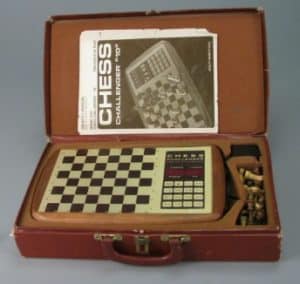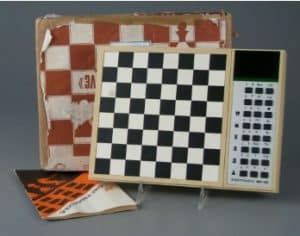Recently for The Strong’s American Journal of Play, I reviewed Garry Fine’s new book on the sociology of chess, and I particularly enjoyed his discussion on the role of computers in chess.
I’ve been a dedicated chess player all my life. Born in 1969, I learned chess at a time when the game surged in popularity, shortly after the American Bobby Fischer defeated the Soviet Grandmaster Boris Spassky for the world championship. By age eight, I was playing at a chess club regularly and then in competitive tournaments. While I’ve stopped competing in tournament play, I still play the game. Sometimes I play with a friend or when I see my brother, but most days I play on my phone.
 Computer chess on a smart phone is the culmination of decades of work. Many early entries on The Strong’s Video Game History Timeline involve the development of chess programs, such as in 1950 when Claude Shannon and Alan Turing (of the film The Imitation Game) developed chess programs. Chess, with its straightforward rules and nearly limitless complexity, provided a perfect medium for early computer scientists to probe the possibilities of programming and push the capacities of computers.
Computer chess on a smart phone is the culmination of decades of work. Many early entries on The Strong’s Video Game History Timeline involve the development of chess programs, such as in 1950 when Claude Shannon and Alan Turing (of the film The Imitation Game) developed chess programs. Chess, with its straightforward rules and nearly limitless complexity, provided a perfect medium for early computer scientists to probe the possibilities of programming and push the capacities of computers.
Given the limited power of computers back then, those pioneering programs were weak, but over the years, more powerful computers and better programming (along with the assistance of expert chess players) progressively improved the capacity of chess programs. And in 1997, the IBM computer Deep Blue triumphed over chess world champion Garry Kasparov in a six-game match. At the time, some commentators thought the machine’s victory represented the death knell of human involvement in chess. What was once considered the apogee of intellectual achievement had evolved into a domain for robots. But as it turned out, people’s interest in chess continues to thrive because computers and people developed a mutualistic—not an antagonistic—relationship across the board.
 In the 1970s and 1980s, programmers and toy manufacturers produced popular commercial chess programs. The Atari 2600, for example, featured a laughably bad chess program. However, programs for home computers were better—ranging from Peter Jennings’ Microchess (1976) to later titles such as Sargon (1980), Chess Master 2000 (1986), and Interplay’s Battle Chess (1988)—a program that animated the normally bloodless capture of the pieces. Still, what I remember best were the stand-alone chess sets with built-in programs like Fidelity’s Chess Challenger. Players moved the pieces on a touch-sensitive board, and the computer responded by lighting up tiny light bulbs embedded in the corners of the 64 squares on the board. In the Soviet Union, the home of the best players in the world, manufacturers began introducing computer chess versions as well.
In the 1970s and 1980s, programmers and toy manufacturers produced popular commercial chess programs. The Atari 2600, for example, featured a laughably bad chess program. However, programs for home computers were better—ranging from Peter Jennings’ Microchess (1976) to later titles such as Sargon (1980), Chess Master 2000 (1986), and Interplay’s Battle Chess (1988)—a program that animated the normally bloodless capture of the pieces. Still, what I remember best were the stand-alone chess sets with built-in programs like Fidelity’s Chess Challenger. Players moved the pieces on a touch-sensitive board, and the computer responded by lighting up tiny light bulbs embedded in the corners of the 64 squares on the board. In the Soviet Union, the home of the best players in the world, manufacturers began introducing computer chess versions as well.
 As these programs rapidly improved, they also helped human opponents enhance their game. One of the real challenges of chess is finding an equally-skilled opponent. Chess is an extremely hard game to self-handicap, so a master finds no pleasure in playing a patzer; the sides are too unequal. Computers provided opponents that would match the ability of each player so that humans now had readily-accessible opponents, who could test them and sharpen their games.
As these programs rapidly improved, they also helped human opponents enhance their game. One of the real challenges of chess is finding an equally-skilled opponent. Chess is an extremely hard game to self-handicap, so a master finds no pleasure in playing a patzer; the sides are too unequal. Computers provided opponents that would match the ability of each player so that humans now had readily-accessible opponents, who could test them and sharpen their games.
Computers also became a great center of chess communities. Online message boards and Internet sites provided hubs for the exchange of chess information, where players could read about the latest championship results, play through catalogs of games, and learn the lines of key chess openings that started the games. Players also began playing each other online, a great improvement over postal chess—the old method of facing off against long-distance opponents, which involved filling out a postcard for every move and then waiting days for the response.
Today, chess is as popular as ever, and computers deserve much of the credit. Excellent smart phone games are available for free, such as Chess with Friends, which my son uses to play against his cousin in Boston. And recently, a live stream on Twitch featured a blitz battle chess match between the American Grandmaster Hikoru Nakamura and the French Champion Maxine Vachier-Lagrave. The players competed live while expert commentators offered turn-by-turn analysis, and spectators chatted about the match and competed to see who could guess the right move. It was exciting and compelling, showcasing how people find new ways to marry the beauties of this ancient game to the capabilities of modern computers.
By Jon-Paul Dyson, Director, International Center for the History of Electronic Games and Vice President for Exhibits
 Hours 10 a.m.–5 p.m. | Fri. & Sat. till 8 p.m.
Hours 10 a.m.–5 p.m. | Fri. & Sat. till 8 p.m.